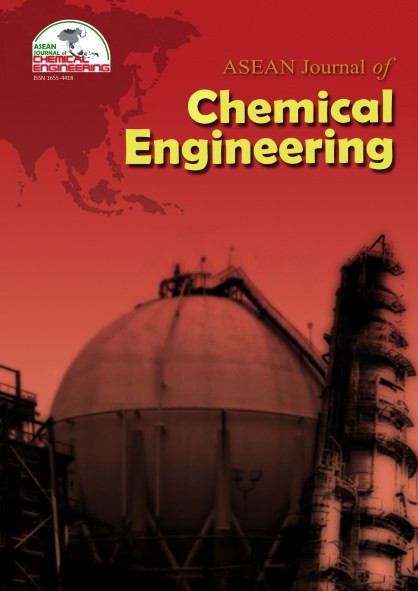Periodic Operation of Reactive Distillation of Dehydrogenation of 2-Propanol
Abstract
The system of 2-propanoVacetone/hydrogen can be effectivelyprovided for a chemical heat pump cycle. This research focuses on the liquid-phase dehydrogenation of 2- propanol to produce acetone and hydrogen at low temperatures under boiling conditions. The acetone produced has been known to have an inhibition effect in the liquid phase. This research examined experimentally the dehydrogenation of 2- propanol in a reactive distillation column with periodic r tlse supply. The conversion of 2-propanol with periodic operation is higher than that with steady-state operation. This behavior can be explained by the acceleration of the reaction rate in the repeated vaporization steps of 2-propanol on the solid catalyst. When 2-propanol enters into the reaction part at the bottom of the column by periodic pulse, the solid catalyst repeats the wet and dry states. Thus, the resistance of mass transfer in the liquid phase and the inhibition effect of acetone both can be reduced. As a preliminary experiment, the reaction rate was measured in a batch reactor by changing the ratio of the moles of 2-propanol to the mass of solid catalyst. The optimum ratio was then found. The effect of pulse interval, feed rate, and the kind of solid catalyst on the conversion was investigated in the reactor with or without the reactive distillation part.References
Gastauer, P., and Prevost, M. (1993). "Dehydrogenation of isopropanol at low temperatures in the vapor phase as a reaction for a chemical heat pump," J. Chem. Eng. Japan, 26, 5, 580-83.
Ito, E., Yamashita, M., Hagiwara, S., and Saito, Y. (1991). "A composite Ru-Pt catalyst for 2-propanol dehydrogenation adoptable to the chemical heat pump system,” Chemistry Letters, 351-54.
Kim, T. G., Yeo, Y. K., and Song, H. K. (1992). "Chemical heat pump-based on dehydrogenation and hydrogenation of i propanol and acetone,” Inter. J. Energy Research, 16, 897-916.
Kobayashi, I., Yamamoto, K., and Kameyama, H. (1999). “A Proposal of a spray-pulse operation for liquid film dehydrogenation 2-propanol dehydrogenation on a plate catalyst," Chem. Eng. Sci., 54, 10, 1319 23.
Saito, Y. (1995). "The properties of liquid film-type dehydrogenation catalytic reaction,” Hyomen, 33, 1, 1-9.
Saito, Y., Kameyama, H., and Yoshida, K. (1987). "Catalyst-assisted chemical heat with reaction couple of acetone hydrogenation/ 2-propanol dehydrogenation for upgrading low-level thermal energy: Proposal and evaluation," Inter. J. Energy Research, 11, 549–58.
Taneda, D., Yasutomi, I., Shibata, S., and Toida, T. (1993), “Studies of 2–propanol/acetone/ hydrogen chemical heat pump characteristics," Kagaku Kogaku Ronbunshu, 19, 5, 729–35.
Copyright holder for articles is ASEAN Journal of Chemical Engineering. Articles published in ASEAN J. Chem. Eng. are distributed under a Creative Commons Attribution-NonCommercial 4.0 International (CC BY-NC 4.0) license.
Authors agree to transfer all copyright rights in and to the above work to the ASEAN Journal of Chemical Engineering Editorial Board so that the Editorial Board shall have the right to publish the work for non-profit use in any media or form. In return, authors retain: (1) all proprietary rights other than copyright; (2) re-use of all or part of the above paper in their other work; (3) right to reproduce or authorize others to reproduce the above paper for authors’ personal use or for company use if the source and the journal copyright notice is indicated, and if the reproduction is not made for the purpose of sale.


